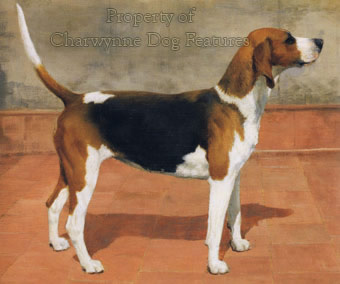627A Victorian Sp dogs
SPORTING DOGS OF THE VICTORIANS
by David Hancock
 In Victorian times, the nobility and landed gentry had a huge influence on dogs, sporting breeds especially. There were 200 packs of Foxhounds, with the Duke of Beaufort and Lords Donerail, Portsmouth, Coventry and Bentinck taking a keen interest. The Dukes of Gordon and of Richmond kept Deerhounds, as did Lords Seaforth, Tankerville and Bentinck. Lord Bagot showed Bloodhounds and Lord Wolverton ran a pack of them in Dorset, later sold to Lord Carrington in Buckinghamshire. The Marquis of Anglesea kept Harriers and Sir John Heathcote-Amory favoured Staghounds. Lord Lurgan's coursing Greyhound Master McGrath won 3 Waterloo Cups out of 4. The Duke of Atholl maintained a pack of Otterhounds. In Borzois, the Duchess of Manchester owned a huge specimen bred by Prince William of Prussia.
In Victorian times, the nobility and landed gentry had a huge influence on dogs, sporting breeds especially. There were 200 packs of Foxhounds, with the Duke of Beaufort and Lords Donerail, Portsmouth, Coventry and Bentinck taking a keen interest. The Dukes of Gordon and of Richmond kept Deerhounds, as did Lords Seaforth, Tankerville and Bentinck. Lord Bagot showed Bloodhounds and Lord Wolverton ran a pack of them in Dorset, later sold to Lord Carrington in Buckinghamshire. The Marquis of Anglesea kept Harriers and Sir John Heathcote-Amory favoured Staghounds. Lord Lurgan's coursing Greyhound Master McGrath won 3 Waterloo Cups out of 4. The Duke of Atholl maintained a pack of Otterhounds. In Borzois, the Duchess of Manchester owned a huge specimen bred by Prince William of Prussia. 
Noble families made a significant contribution to the gundog breeds: Lord Tweedmouth in Golden Retrievers, the Earl of Malmesbury and Lord Knutsford in Labradors, Viscount Melville in Curly-coats, the Earls of Sefton, Lichfield and of Derby in Pointers, the Duke of Gordon in his type of setters, the Earl of Tankerville and Lord Waterpark in English Setters and the Duke of Newcastle, Lords Middleton and Spencer in Clumbers. This is an impressive list but a very noticeable difference between the patronage of breeds of dog in Victorian times and now, is the almost negligible involvement of the nobility nowadays. 
Once, their interest guaranteed support for many breeds, a higher profile for the Kennel Club and the promotion of dogs for their sake rather than the bank balance. However I believe it is fair to state that the major contribution to the development of breeds as such came from 'lower down' the Victorian social scale, from the more plebian fanciers, as well as the dedication of the squires and yeomen breeders. In gundogs for example the likes of Llewellin and Laverack achieved longer-lasting impact, whilst in the Foxhound world the legendary 'Ikey' Bell restored soundness at a time when so many Masters of Foxhounds had lost their way; the strange seeking of 'great bone' handicapping hounds when hunting.
Queen Victoria's long reign witnessed huge changes to Britain and the world and the world of dogs was no exception, undergoing changes with far-reaching implications. Britain had a wide reputation as a breeder of livestock; the existence of Empire ensured that British sporting styles and social trends soon spread all over the globe. When, in the days before quarantine, British landed gentry went on sporting tours, their dogs went with them. When British livestock was exported, the herding dogs went too. When the British emigrated or went to work for extended periods in places like India, their dogs went with them. In the second half of the nineteenth century British dogs, sporting dogs especially, became known and highly rated in most parts of the world.
This widening influence was accompanied by changes at home; dog shows became fashionable, field trials were introduced and both hunting and shooting became 'must-do' events in the countryside. Shows and trials brought a need for registration so that a dog's identity could be verified. As the range and frequency of shot increased so the needs of sportsmen in their supporting dogs changed too. In the hunting field the better breeding of hounds received much more attention. Companion dogs too were influenced by greater foreign travel and the subsequent introduction here of exotic breeds from distant places. At the same time came more focus on animal welfare, the moral repugnance towards some barbaric so-called 'sports', greater concern over the plight of street-dogs, draught-dogs especially, and a move towards more enlightened training and less 'breaking' of dogs. 
Royal patronage and the obsessive interest of the nobility in field sports gave some types of dog a higher profile. But the desire to produce dogs which closely resembled their parents and bred true to type, a fall-out of the show ring, led to the production of pure breeds. Of course, before that, breed-type had been established in many cases with Greyhounds, Harriers, Beagles, Pointers and Deerhounds usually looking like their ancestors. But from now on closed gene pools were to be respected and purity of breeding revered. For the first time in dogdom, it wasn't just a case of breeding good dog to good dog, both parents had to be registered and out-crossing was frowned upon. This has persisted more in the gundog world than say the terrier world or the hunting field.
This pursuit of breed purity has had a marked effect on the well-being of the dog. Breeding from a closed gene pool is fine when things are going well but disastrous when inbred faults and genetic flaws are encountered. The Victorian era may have given us the breeds but it has also given us the problems arising from in-breeding, conducted for a century in some cases. Our lives have been enriched by the breeds of dog handed down to us by our Victorian ancestors; now we must use scientific advances and increased veterinary knowledge to capitalise on and not be penalised by the admirable pioneering work done by the Victorians. This is the great challenge for sportsmen who prize their breeds in the new century.